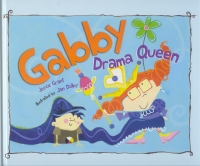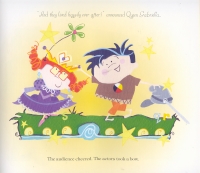| ________________
CM . . . . Volume XX Number 23 . . . . February 14, 2014
excerpt:
In Gabby, Drama Queen, the second book in Joyce Grant's "Gabby" series, Gabby and her friend Roy come together to put on a stage play in Gabby's backyard. Similar to the first Gabby book, which was simply called Gabby, the second book also includes the use of spelling words within the text to engage the child characters in creative play. In this story, Gabby is not the solitary human character she was in the previous story. In Gabby, Drama Queen, she is joined by her friend Roy who helps her spell out all the things they will need to put on a play. After dressing up like a queen, Gabby uses her special storybook to bring letters and words together to create an imaginative day of drama. Her friend Roy also enjoys the spelling game and brings forward his own input on how their stage play should unfold.
There are numerous elements in this picture book that will keep young children entertained. As in the previous Gabby story, a funny little blue bird appears or is hidden on each page. Many other creatures, such as the cat and the frog from the first book, also appear throughout the illustrations. The children's play also appears as a story within the story when the font of the text changes in that section of the book to introduce The Perils of Queen Gabriella. Gabby, Drama Queen comes to an end with the children and their very entertained neighbour sitting down to tea. Also included again in the final pages of the book are new spelling and drawing games that parents or teachers can introduce to children for further entertainment and learning. Recommended. Vasso Tassiopoulos is a graduate of the Master of Arts program in Children's Literature at the University of British Columbia.
To comment
on this title or this review, send mail to cm@umanitoba.ca.
Copyright © the Manitoba Library Association. Reproduction for personal
use is permitted only if this copyright notice is maintained. Any
other reproduction is prohibited without permission.
NEXT REVIEW |
TABLE OF CONTENTS FOR THIS ISSUE
- February 14, 2014.
AUTHORS |
TITLES |
MEDIA REVIEWS |
PROFILES |
BACK ISSUES |
SEARCH |
CMARCHIVE |
HOME |

 Through the two young protagonists, child readers will also learn the importance of cooperation, as Gabby initially disagrees with Ray's insistence of playing a swordfish. By keeping an open mind, Gabby comes to see that Roy's being a swordfish works well for their play. In the story, readers are also introduced to Gabby's neighbour, Mrs. Oldham, who jumps over the fence to enjoy the children's play as a member of their audience. Dolby's illustrations bring to life the friendly collaborative nature of the children and the eccentric appearance of their neighbour, which is not evident through text alone. Jan Dolby's vibrant illustrations also highlight the fun and action experienced by the two children as they work together. Their camaraderie is also complemented and strengthened through the illustrations. Children of a young age will take an interest in Gabby and Roy's creativity as the two work together to pull letters out of backyard surroundings to create a stage so that they can perform their play.
Through the two young protagonists, child readers will also learn the importance of cooperation, as Gabby initially disagrees with Ray's insistence of playing a swordfish. By keeping an open mind, Gabby comes to see that Roy's being a swordfish works well for their play. In the story, readers are also introduced to Gabby's neighbour, Mrs. Oldham, who jumps over the fence to enjoy the children's play as a member of their audience. Dolby's illustrations bring to life the friendly collaborative nature of the children and the eccentric appearance of their neighbour, which is not evident through text alone. Jan Dolby's vibrant illustrations also highlight the fun and action experienced by the two children as they work together. Their camaraderie is also complemented and strengthened through the illustrations. Children of a young age will take an interest in Gabby and Roy's creativity as the two work together to pull letters out of backyard surroundings to create a stage so that they can perform their play.